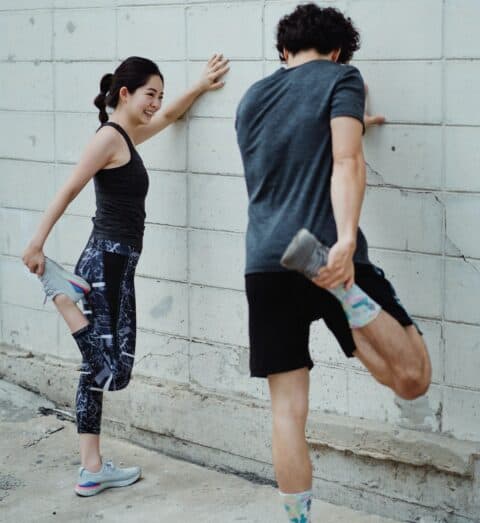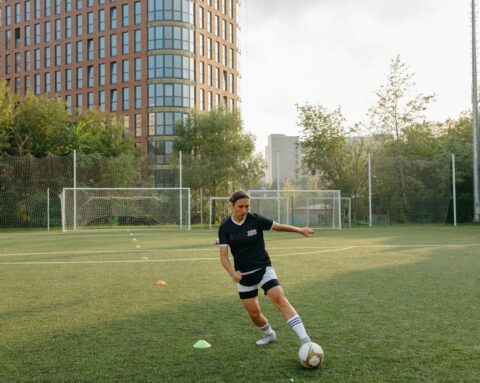Plantar Fasciitis is a common cause of heel pain due to overuse, strain and inflammation of the plantar fascia ligament. The plantar fascia ligament is a thick and strong tissue that runs along the bottom of the foot connecting the toes to the heel, meaning that the affected tissue is under the arch of the foot. Although, the sharp pain often associated with plantar fasciitis is felt in the heel. Thankfully, there are many things we can do to recover from the injury as quickly as possible.
Plantar Fasciitis is an injury that appears out of the blue for no obvious reason. It is, however, triggered by one of two possible ways known as compression or traction injuries. Plantar fasciitis can be commonly seen in people with poor foot genetics or biomechanics that cause strain on the plantar fascia. Having weak foot arch control and flat feet are two very common causes of plantar fasciitis. It is also often seen and associated with sports that involve running on your toes or high impact sports.
Traction, in this case, refers to stretching. When stretching forces are placed on the plantar fascia and it becomes overstretched; plantar fasciitis often occurs. The major reasons for this, in particular, are poor foot biomechanics such as over-pronation or having a weakness in your foot arch muscles. Compression plantar fasciitis is caused through impact such as landing on a sharp object. This can be identified also by the pain being felt further toward one’s arch as opposed to the heel.
Plantar fasciitis symptoms are quite obvious as your pain will be quite intense and often felt during the first steps of the day or after rest. Alternatively, it can be felt through quick changes in weight bearing or activity. Other Symptoms include sharp pain on the bottom of the heel, heel pain after exercise, mild swelling around the heel, heel pain that grows stronger after being on tiptoes, heel pain that grows worse after climbing stairs. People most at risk of developing plantar fasciitis include people who are active, overweight, on your feet often, in their middle age or older, diabetes, arthritis, with weak arches, pregnant and people with high arches of flat feet.
Now that we have discussed all the negatives associated, we should take a look at the positives of plantar fasciitis treatments! Plantar fasciitis is completely reversible and able to be successfully treated. Around 90% of people experiencing plantar fasciitis will have a lot of improvement within two months of treatment. It is important however to catch onto plantar fasciitis as soon as possible.
There are many techniques and methods used by therapists to help you recover from your plantar fasciitis including, joint mobilisation exercises, soft tissue massage, stretches, foot taping and strengthening exercises. However, the most important thing to begin with as always for soft tissue injuries is RICE. During the early stages of plantar fasciitis, it is going to be unlikely for you to walk around pain-free. An ice foot roller, as seen in our Facebook videos section can provide some relief during the early stages.
One of the most important things you can do in your recovery from plantar fasciitis is getting your therapist to analyse the biomechanics of your feet. Our specialists at Studio Musculoskeletal are highly trained in identifying your foot control and analysing your needs in regard to exercises and footwear. Whilst it is true that treatments will vary from person to person, many of us wear the wrong types of shoes on a day to day basis that do not provide the required arch support. Identifying your walking or running style is a key factor in getting you the right shoe during the road to recovery.
Foot stabilisation exercises and stretches are the most effective way to rehabilitate your plantar fasciitis. Important foot arch muscles could be weak or have lower levels of tolerance to your workload. Speak to your therapist about assessing and correcting your foot control. It is extremely important to utilise these exercises and stretches to correct the biomechanics of your feet.
Some excellent stretches for plantar fasciitis can also be seen at our Facebook and Instagram pages.
Once your foot biomechanics have been assessed it is possible that you will be offered a custom made orthotic prescribed by a podiatrist. Your running or landing technique may have played a large part in your plantar fasciitis if it was brought on due to sport. Therefore, a reoccurrence can only be prevented by addressing the technique you are using on a week to week basis, in those sports. It can be important to have your therapist identify any stiff joints within your feet and ankle. These joints will need to be loosened to help you avoid over stress in your plantar fascia.
The approximate recovery time for plantar fasciitis is anywhere from several weeks to many months. It is difficult to predict just how long it will take as every case has a different cause and bio-mechanical makeup thus creating many different potential recovery cases. As discussed earlier, it is extremely important to get on top of your plantar fasciitis as soon as possible to have the greatest and quickest chances of recovery. Our highly skilled therapists at Studio Musculoskeletal will be able to create a tailored plan specific to your lifestyle and help you recover in the most efficient and effective way possible.






